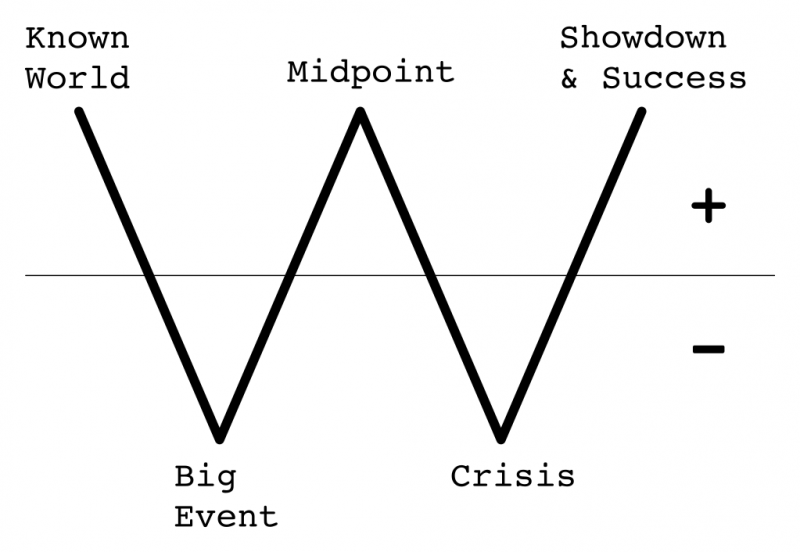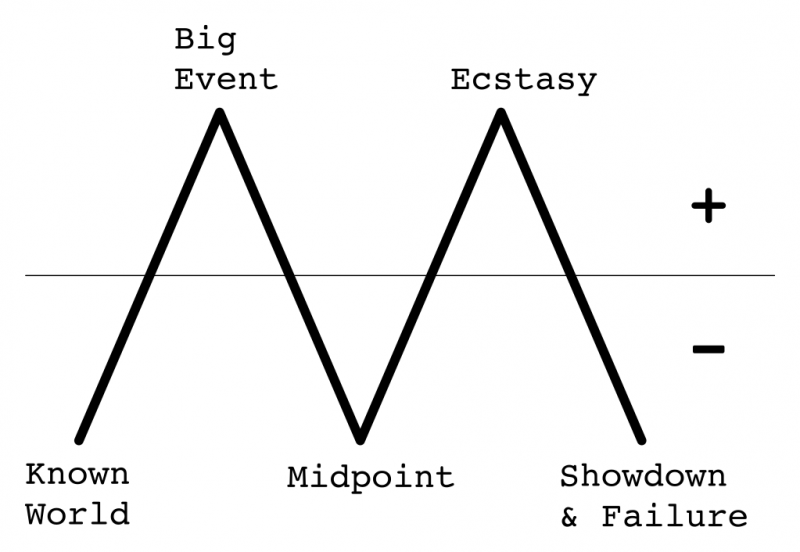Continues Finding crisis (Structure part 2).
One relationship in which contrast is applied is the one between the crisis and the ultimate story end. Whether it is a good or a bad ending, the crisis must be the opposite. A story that ends positively contains a crisis, and in the same way, a story with a negative ending has a state of ecstasy at the end of act 2.
Attempting to do the alternative would lead to a badly-told story. To have a character experience a (negative) crisis only to go on into a showdown and fail again, would mean that there is no change at all. The protagonist would be running against a wall. The situation stays the same. But if nothing changes, why bother telling the story at all? Or, in this particular instance: What’s the use of the third act, when it comes to the same end as the second? Contrast matters.
Of course, a high-contrast relationship matters not only between crisis and showdown, but for all parts of the story.
A story with a good ending has to start appropriately. Ideally, in the beginning is the known world, which is perceived by the protagonist as positive. Everything is well, albeit not much happens (act 1 = inert). This state is broken by the big event, which stands in contrast to the known world. It is a negative event, that starts off the whole story. It lays the foundation for an ongoing up-and-down, a continuation of contrast.
After the big event, the hero has to deal with the unknown world of the second act. As they learn to cope with the changed situation the story rises to the positive midpoint. Here, an event occurs that breaks the protagonists stride and turns the story back into the other direction. (Sometimes, a film will be very ironic in applying such a turning point, by having a positive scene first, in which the character celebrates their success, but then interrupting this scene for a turning point; and everything falls down from here.)
The story falls back into negativity and arrives at the crisis. The protagonist must find a way to turn around and engage in a last showdown, which will be ultimately victorious. In this end state the hero might realize that the story they went through wasn’t so bad after all, but an opportunity for positive growth and change. The perception of the known world will change, it might be hard for the character to understand why that bygone era was ever positive. They have adapted to the unknown world and made it their own.
A story ending badly would be the exact opposite of all that. For a big part of the story the protagonist would be filled with high hopes, being the most ecstatic at the end of act 2 (the crisis in a good story), only to be most definitely and irreversibly defeated in the showdown.
Graphed out, a good story would look like this:

And a bad story would look like this:

Actually, both types of story are very similar – they both have a constant up and down, like a zigzag curve. In the end, it matters where the story starts off (good or bad) and where it ends. But contrast is always of great importance. Hence, a good story must have bad moments – those life-and-death situations that make a success in the end so much more invigorating, and a bad story must have positive scenes, in order to show the audience the potential for where this story could end up, but doesn’t.
One more thing: In order to have a full story, a certain minimum amount of turning points must exist. Simply going from a positive state to a negative one, would not be much of a story. It would be boring. On the other hand, stringing on ever more ups and downs becomes harder and harder for the author. New challenges would have to be brought up, and at some point their quality will surely suffer. This is basically the core reason why even successfull TV series have to end eventually – at some point the makers are all out of good ideas.
One thought on “Finding contrast (Structure part 3)”
Comments are closed.